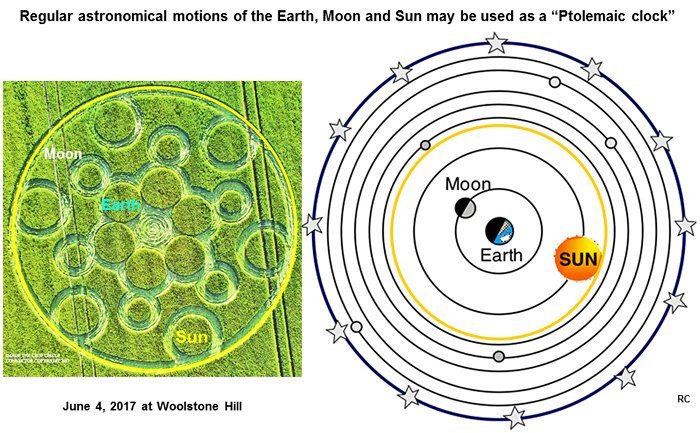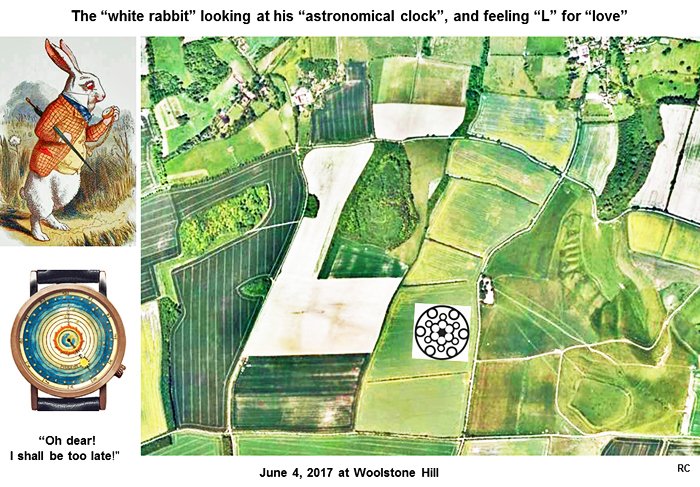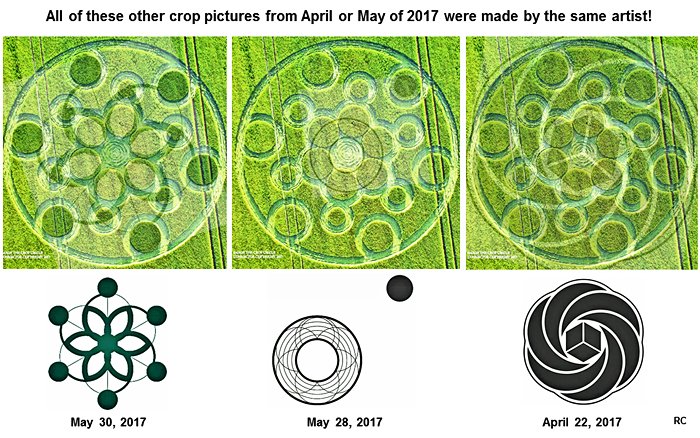Formation was first spottet on 4th June 017 near Woolstone Hill, Oxfordshire/England

The formation is in well-advanced winter barley about 80cm tall and is softly laid to a variety of different degrees. Some parts are laid almost flat but most are laid at 'half-pressure' with many stalks still standing interspersed in the lay. Nearly all the half-laid stalks were bent from the base rather than the nodes, so the whole stalks were leaning at the same angle. Some nice features I saw and which you might be able to see on the photos, were the flow of interweaving stalks in the more fully laid sections; the chequerboard effect of the 'half-laid' sections; and the smooth transitions between the two. The formation was very little trampled and in excellent condition at 17:00 on Sunday.
Video:
Interpretation:
Regular astronomical motions of the Earth, Moon and Sun may be used as a “Ptolemaic clock”
The crop artists apparently use regular astronomical motions of our Earth, Moon and Sun as a kind of “astronomical clock”:

This particular “clock” (as drawn in crops) seems to be of the Earth-centred, Ptolemaic variety, which was used on Earth for thousands of years, before Copernicus and Galileo made their great discoveries in the 16th or 17th centuries A.D.
This new crop picture at Woolstone Hill has been highly stylized in an artistic sense, so that it only shows six possible positions for our “Sun” around the outer perimeter, over the course of one full solar year. It also shows just six alignments of our “Earth and Moon” as “new Moons” in phase, six times per solar year (whereas the true number is 12.37).
During a solar eclipse, such as the one we will see on August 21, 2017, both of those “Sun” and “Earth-Moon” circles will coincide.
When we study the landscape close to where this crop picture appeared (using Google Earth at latitude 51.575o N, longitude 1.579o W, near the Uffington White Horse), we can see what seems to be the image of a large “rabbit” who is “sitting on his haunches”, while contemplating a crop picture which was drawn below and to the right:

This large “rabbit” motif resembles a famous character from “Alice in Wonderland”, called the “white rabbit”. It has been seen in the landscape twice recently near crop pictures at Chilcomb Ranges on August 3, 2016, or Oxleaze Copse on May 21, 2017. The “Cheshire Cat” from “Alice” was likewise drawn twice in crop pictures at Wilton Windmill on July 15, 2016, or Figsbury Ring on July 22, 2016.
These new landscape features at Woolstone Hill, the third of their kind, seem to show a “white rabbit” who is looking at his “watch” (or his “astronomical clock”), while muttering “Oh dear! I shall be too late!” Then he hops down into a rabbit hole and enters Wonderland, and travels from one reality to another.
Three other “astronomical clocks” were drawn in crops recently at Cherhill on April 17, 2017 as a “lunar pendulum”, at Willoughby Hedge on May 4, 2017 as “rotating lunar nodes”, or at Oxleaze Copse on May 21, 2017 as a “12-month lunar calendar”.
Within the “body” of that landscape “rabbit” at Woolstone Hill, we can see a large, white letter “L”. This often stands in crop-circle symbology for “love”. Two other large letters “L” were seen in the landscape next to new crop pictures at Fonthill Down in England on May 30, or Le Birou in France on June 2, just a few days before this new crop picture appeared at Woolstone Hill in England on June 4.
When we compare the stylistic features of this new crop picture at Woolstone Hill on June 4, with others that have appeared previously at Fonthill Down on May 30, Summers Hill on May 28, or Waden Hill on April 22, we can see that all of them were probably made by the same “artist”:

Want more crop formations? Visit http://www.cropcircleconnector.com
click here!This post received a 1.7% upvote from @randowhale thanks to @cropcircles! For more information,